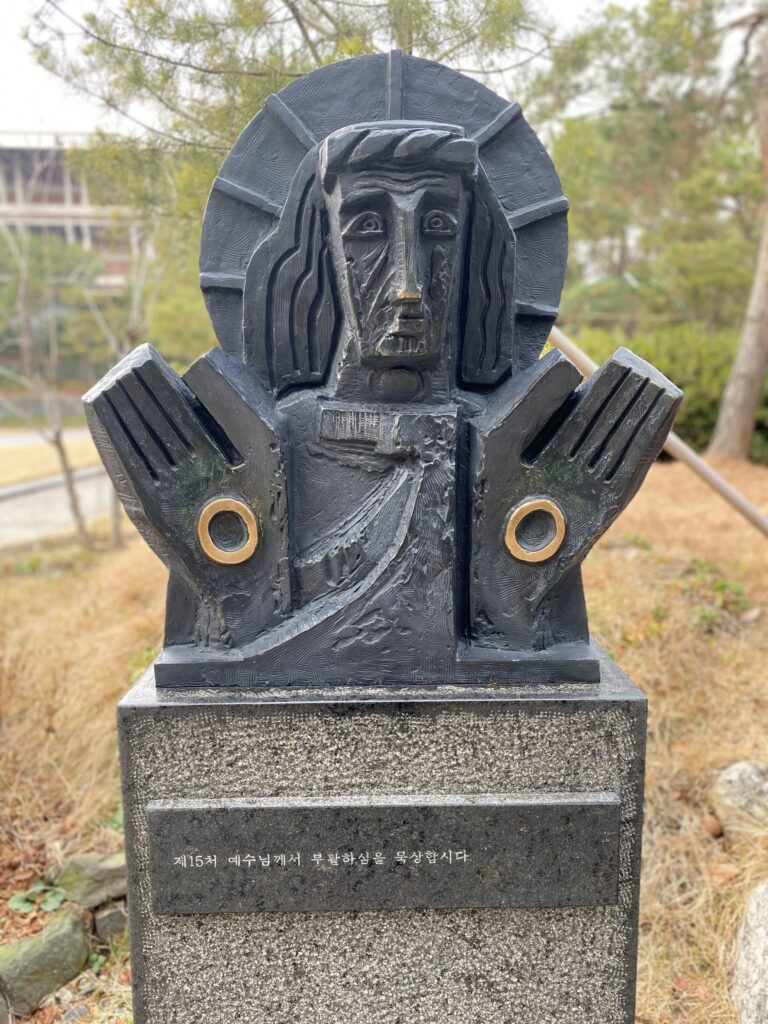John Sampson is a recent graduate of the conjoint PhD program through St. Michael’s College and the University of Toronto. In December 2022 he received a postdoctoral fellowship through the Ricci Institute at Boston College to participate in a weeklong workshop in Seoul, South Korea, which focused on the historical legacies of Christianity in East Asia. John is a course instructor at St. Michael’s College and the coordinator of graduate programs at the Toronto School of Theology.
It was a cool December afternoon in Hapjeong-Dong, not far from the Gukhoe, South Korea’s National Assembly building in Seoul city. Mist hung in the air as we ascended the wooden staircase on Jeoldusan, the Beheading Mountain, where 200 Korean Catholics were martyred during the Byeong-in persecution (1866-1873). Jeoldusan, which became a Catholic shrine and national historic site in 1956, bore the painful memory of 1866, the year of “Western disturbance.” The French, seeking to subvert the anti-Catholic regent Daewongun and further colonial expansion into Korea, seized control of territory near modern-day Seoul. Korean Catholics, perceived as supporters of the French fleets, were rounded up in October 1866 and beheaded.

Along the martyrs’ mountain path were beautiful cobblestones and well-trimmed hedges that sat uncomfortably with the memory of 1866. Magpies clicked and cawed in the distance. Our tour group followed the martyrs’ last footsteps, winding up Jeoldusan to a small chapel where their names were etched in stone. We made our way to the chapel, went down into the basement and to the reliquary, their final resting place. A long silence followed. John Park Lao-ho, Mary Kim I-beun, Francis Lee Ui-song, Maoro Yu were among the many names called upon, interrogated, and executed in October 1866. Their testimonies, documented with Confucian precision by the ruling officials at their interrogation, consisted of refusals to apostatize, to turn one’s back on God, to betray Christ. “It’s normal for me to die, not to deny my faith,” Augustine Lee Yong-lae stated. “I will die for my Lord,” John Kang declared.
The Jeoldusan shrine stood as a living reminder of how Christians throughout history have embarked upon the way of Jesus Christ, the way the Apostle Paul described as being “crucified with Christ” (Gal 2:19). This became abundantly clear not only when I heard the martyrs’ stories but when I saw stations of the cross surrounding the mountain path. Completed in 2001 by artist Lee Choon-mann, each station depicted Christ with an indigenous Korean style, vividly displaying the man of sorrows on his long walk into death. I lingered at the final station. Confronted by the resurrected Christ, my eyes fixated on the holes in his hands.
Jeoldusan is a now a place of peace and respite, tucked away from the bustling activity of South Korea’s capital city. It is a sacred site for the Korean Catholic Church and place of pilgrimage for Christians all around the world. John Paul II and Mother Theresa visited in the 1980s. Before we concluded our tour at the entryway gift shop, we visited the museum beside the chapel. A large skylight shone down from the centre ceiling, creating what architect Kim Seunghoy says is an intentional narrative of architectural space— the gentle light resembling the call to martyrdom from the divine flooding the room. The exhibition hall displayed pristine records pertaining to the Catholic Church’s battered history in Korea: letters of St. Andrew Kim Tae-gon, one of the earliest Korean Catholic priests executed in 1846, eye-witness accounts and interrogation records from the Byeong-in persecution, rosaries.
The memory of Christian persecution was uncovered and polished like jade. Centuries-old documents were retrieved. Stories were retold. The martyrs’ legacy lived on. Upon leaving the museum and looking over the shrine’s well-kept grounds, I couldn’t help thinking about the forgotten experiences of persecution in history. How many places like Jeoldusan were out there, but without someone to steward their memory? How many shrines still need constructing? We grabbed coffee near the gift shop and descended the wooden staircase to our bus, which carried us back into the busy world.
Read other InsightOut posts.
